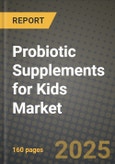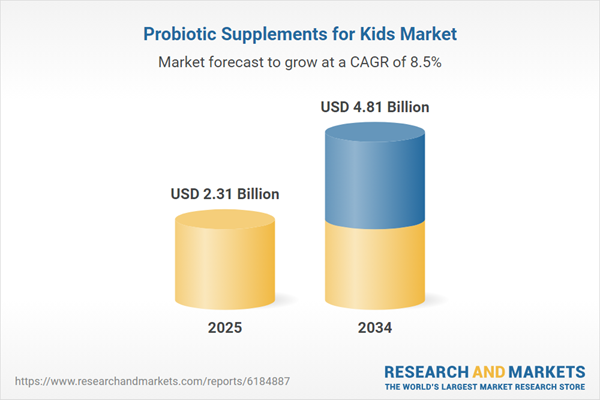Probiotic Supplements for Kids Market
The Probiotic Supplements for Kids market sits at the intersection of pediatric nutrition, preventive wellness, and clean-label consumerism. Parents, pediatricians, and pharmacists increasingly view microbiome support as part of everyday immunity and digestive health routines, spurring demand for age-specific formulations that are safe, palatable, and clinically substantiated. Top applications span daily immunity support, digestive regularity, management of antibiotic-associated gut disturbance, and general wellness in school-age children and toddlers; infant drops and powders address the earliest life stages, while gummies and stick packs dominate older kids due to taste and convenience. The latest trends include synbiotics (probiotic + prebiotic), heat-stable and spore-forming strains enabling ambient storage, transparent CFU and strain naming on packs, sugar-reduction via stevia/monk-fruit, allergen-free and vegan options, and emerging “postbiotic” and paraprobiotic concepts for stability and claim consistency. Drivers center on rising parental health literacy, pharmacist and pediatrician recommendations, expanding e-commerce and D2C subscriptions, and robust brand storytelling anchored in clinical papers on well-known strains. The competitive landscape features a blend of global nutrition companies, pediatric-focused specialty brands, pharmacy and grocery private labels, and digital-native challengers leveraging tele-pediatrics and influencer education. Differentiation hinges on strain pedigree and dossier depth, delivery technology (microencapsulation, acid-resistant formats), taste/texture innovation, third-party certifications, and compliance with evolving claim standards. As retailers build gut-health sets and schools emphasize attendance and resilience, the category is maturing from episodic to daily-use; yet brand trust, label clarity, and responsible claims remain decisive, especially across markets with stricter interpretation of pediatric supplement advertising.Probiotic Supplements for Kids Market Key Insights
- Clinically characterized strains as the trust anchor
- Dosage form dictates adherence in kids
- Stability technology expands channel reach
- Synbiotics and gentle prebiotics for tolerance
- Rise of postbiotics and paraprobiotics
- Medical-channel influence shapes retail
- Transparency and certifications as credibility cues
- Responsible claims and evolving compliance
- Digital discovery and subscription economics
- Innovation beyond the capsule
Probiotic Supplements for Kids Market Reginal Analysis
North America
Retailers are expanding dedicated “kids’ wellness” bays, with pharmacists guiding parents toward strain-specific, sugar-reduced options. Subscription D2C remains strong, aided by fast shipping and bundle discounts that pair probiotics with multivitamins and omega-3s. Claims scrutiny in digital advertising encourages evidence-led storytelling and clear age labeling. School calendars drive cyclical demand, and ambient-stable formats gain space in mass, club, and convenience channels. Private label grows in grocery and pharmacy, but branded leaders maintain share via clinical dossiers and HCP programs.Europe
Stringent interpretation of claims fosters conservative positioning and meticulous pack language, favoring brands with robust clinical substantiation and precise strain disclosure. Pharmacies dominate recommendation pathways, and dosage forms trend to sugar-light chewables and drops. Northern and Western markets emphasize clean-label and allergen transparency, while Central/Eastern Europe adopts more rapidly through value-engineered SKUs. Refrigerated lines persist in select countries, yet shelf-stable innovations increasingly replace cold chain. Cross-border e-commerce supplements pharmacy access.Asia-Pacific
Urbanizing, digitally savvy parents drive rapid adoption through marketplaces and social commerce, with strong interest in immunity and digestive comfort for school readiness. Heat-stable and spore-forming strains are favored for climate and logistics; stick packs and sachets align with on-the-go routines. Local regulations on import registration and infant claims shape launch sequencing, prompting partnerships with regional distributors. Premiumization rises in developed markets, while value-tier offerings and family-size packs expand reach in emerging economies. Education around dosing during antibiotic courses is a common entry narrative.Middle East & Africa
Market entry concentrates on pharmacy and pediatric clinic channels, where HCP trust is pivotal. Ambient-stable formats overcome temperature and supply-chain constraints, and halal-compliant inputs bolster acceptance. Parents prioritize gentle formulations with simple ingredient lists and clear dosing for toddlers. E-commerce adoption is accelerating in Gulf markets, enabling direct education and subscription pilots. Regulatory approvals and localized pack language are key to speed of shelf placement and prescriber support.South & Central America
Pharmacies and mom-and-baby stores anchor distribution, with growing marketplace sales in metropolitan areas. Taste-forward gummies and flavored powders resonate, yet sugar-conscious reformulations and clear CFU statements differentiate premium offerings. Currency volatility elevates the role of locally manufactured or regionally packaged SKUs, while partnerships with pediatric associations enhance credibility. Education campaigns focus on antibiotic-associated gut support and daily routines for school-age children, with trial packs and value multipacks driving household penetration.Probiotic Supplements for Kids Market Segmentation
By Type
- Lactobacillus
- Streptococcus
- Bifidobacterium
- Others
By Form
- Gummies
- Capsules
- Powders
- Softgels
- Others
Key Market players
Culturelle, BioGaia, Florastor, Align, Garden of Life, Renew Life, Nature’s Way, Jarrow Formulas, NOW Foods, LoveBug Probiotics, Hyperbiotics, OLLY, SmartyPants Vitamins, Nordic Naturals, MaryRuth Organics.Probiotic Supplements for Kids Market Analytics
The report employs rigorous tools, including Porter’s Five Forces, value chain mapping, and scenario-based modelling, to assess supply-demand dynamics. Cross-sector influences from parent, derived, and substitute markets are evaluated to identify risks and opportunities. Trade and pricing analytics provide an up-to-date view of international flows, including leading exporters, importers, and regional price trends.Macroeconomic indicators, policy frameworks such as carbon pricing and energy security strategies, and evolving consumer behaviour are considered in forecasting scenarios. Recent deal flows, partnerships, and technology innovations are incorporated to assess their impact on future market performance.
Probiotic Supplements for Kids Market Competitive Intelligence
The competitive landscape is mapped through proprietary frameworks, profiling leading companies with details on business models, product portfolios, financial performance, and strategic initiatives. Key developments such as mergers & acquisitions, technology collaborations, investment inflows, and regional expansions are analyzed for their competitive impact. The report also identifies emerging players and innovative startups contributing to market disruption.Regional insights highlight the most promising investment destinations, regulatory landscapes, and evolving partnerships across energy and industrial corridors.
Countries Covered
- North America - Probiotic Supplements for Kids market data and outlook to 2034
- United States
- Canada
- Mexico
- Europe - Probiotic Supplements for Kids market data and outlook to 2034
- Germany
- United Kingdom
- France
- Italy
- Spain
- BeNeLux
- Russia
- Sweden
- Asia-Pacific - Probiotic Supplements for Kids market data and outlook to 2034
- China
- Japan
- India
- South Korea
- Australia
- Indonesia
- Malaysia
- Vietnam
- Middle East and Africa - Probiotic Supplements for Kids market data and outlook to 2034
- Saudi Arabia
- South Africa
- Iran
- UAE
- Egypt
- South and Central America - Probiotic Supplements for Kids market data and outlook to 2034
- Brazil
- Argentina
- Chile
- Peru
Research Methodology
This study combines primary inputs from industry experts across the Probiotic Supplements for Kids value chain with secondary data from associations, government publications, trade databases, and company disclosures. Proprietary modeling techniques, including data triangulation, statistical correlation, and scenario planning, are applied to deliver reliable market sizing and forecasting.Key Questions Addressed
- What is the current and forecast market size of the Probiotic Supplements for Kids industry at global, regional, and country levels?
- Which types, applications, and technologies present the highest growth potential?
- How are supply chains adapting to geopolitical and economic shocks?
- What role do policy frameworks, trade flows, and sustainability targets play in shaping demand?
- Who are the leading players, and how are their strategies evolving in the face of global uncertainty?
- Which regional “hotspots” and customer segments will outpace the market, and what go-to-market and partnership models best support entry and expansion?
- Where are the most investable opportunities - across technology roadmaps, sustainability-linked innovation, and M&A - and what is the best segment to invest over the next 3-5 years?
Your Key Takeaways from the Probiotic Supplements for Kids Market Report
- Global Probiotic Supplements for Kids market size and growth projections (CAGR), 2024-2034
- Impact of Russia-Ukraine, Israel-Palestine, and Hamas conflicts on Probiotic Supplements for Kids trade, costs, and supply chains
- Probiotic Supplements for Kids market size, share, and outlook across 5 regions and 27 countries, 2023-2034
- Probiotic Supplements for Kids market size, CAGR, and market share of key products, applications, and end-user verticals, 2023-2034
- Short- and long-term Probiotic Supplements for Kids market trends, drivers, restraints, and opportunities
- Porter’s Five Forces analysis, technological developments, and Probiotic Supplements for Kids supply chain analysis
- Probiotic Supplements for Kids trade analysis, Probiotic Supplements for Kids market price analysis, and Probiotic Supplements for Kids supply/demand dynamics
- Profiles of 5 leading companies - overview, key strategies, financials, and products
- Latest Probiotic Supplements for Kids market news and developments
Additional Support
With the purchase of this report, you will receive:- An updated PDF report and an MS Excel data workbook containing all market tables and figures for easy analysis.
- 7-day post-sale analyst support for clarifications and in-scope supplementary data, ensuring the deliverable aligns precisely with your requirements.
- Complimentary report update to incorporate the latest available data and the impact of recent market developments.
This product will be delivered within 1-3 business days.
Table of Contents
Companies Mentioned
- Culturelle
- BioGaia
- Florastor
- Align
- Garden of Life
- Renew Life
- Nature’s Way
- Jarrow Formulas
- NOW Foods
- LoveBug Probiotics
- Hyperbiotics
- OLLY
- SmartyPants Vitamins
- Nordic Naturals
- MaryRuth Organics.
Table Information
| Report Attribute | Details |
|---|---|
| No. of Pages | 160 |
| Published | November 2025 |
| Forecast Period | 2025 - 2034 |
| Estimated Market Value ( USD | $ 2.31 Billion |
| Forecasted Market Value ( USD | $ 4.81 Billion |
| Compound Annual Growth Rate | 8.5% |
| Regions Covered | Global |
| No. of Companies Mentioned | 15 |









